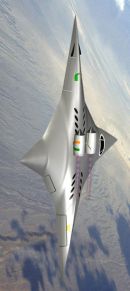



Zha, who is collaborating with peers from Florida State University on the concept design, said "there’s no limit" to the potential speed the star-shaped airframe could allow, with single-stage to orbit and hypersonic speeds (above Mach 5) well within the realm of possibility. That speed would be delivered with low drag, low fuel consumption, and no sonic boom — the noise of which has stalled previous attempts to create supersonic travel routes over populated areas.
While the concept design is sized as a business jet, Zha said there should be little difficulty scaling it up to airline size.
Zha, who has followed recent difficulties that the U.S. Air Force has had launching a missile to Mach 5, said propulsion and aerodynamic challenges must be overcome, and many of those challenges still are not well-understood. It may take decades to solve some of the problems faced by all hypersonic designs.
Still, Zha said, the bi-directional design "does provide a very promising configuration." By combining the virtues of two very different wings, the concept sidesteps — literally — one of the major challenges posed by high-speed flight: Wings that provide the lift required for low-speed maneuvering, including takeoff and landing, produce too much drag to be efficient at supersonic speeds. An ideal high-speed wing, on the other hand, would be downright dangerous in the traffic pattern.
Computer models predict the bi-directional aircraft would perform well both at low speeds — taking off and landing from airports — and at high speed. Making the 90-degree rotation that exchanges wings would be a complicated maneuver, controlled by a computer to span the transition over several seconds and make the change barely perceptible to passengers and crew in flight. As engines rotate and control forces transfer to different sets of control surfaces, passengers would feel an acceleration of just 0.2-Gs as the aircraft rotated on its axis, Zha said, noting the concept has been extensively modeled in digital form. Long, thick wings designed for low-speed flight would rotate to the longitudinal axis, and shorter, thinner wings better suited for efficient high-speed flight would provide lift at supersonic speeds — and beyond.The funding from NASA’s Innovative Advanced Concepts grant program is just enough to begin wind tunnel testing, Zha said. Design refinement and mission analysis will also be paid for with the one-year grant; Zha hopes to secure a Phase II grant from the same NASA program that would bring another $500,000, but that is still a small amount relative to what will be required to build a prototype. Zha said private investment could accelerate the process, and make a certified aircraft available in as little as a decade.
"If we have all the money we need, probably 10 years could be doable," Zha said.
A more realistic estimate, however, puts this new design in the air in about 20 years, Zha said, noting that the research team is eager to work with private investors interested in speeding things up.
September 5, 2012
MORE (Flying Wing)
